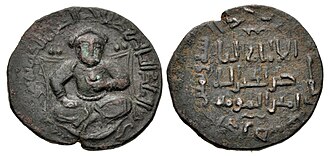| Revision as of 11:30, 6 February 2024 editपाटलिपुत्र (talk | contribs)Autopatrolled, Extended confirmed users74,385 edits ce← Previous edit | Revision as of 16:04, 6 February 2024 edit undoHistoryofIran (talk | contribs)Autopatrolled, Extended confirmed users, Pending changes reviewers97,640 edits lets add three regular coin images (two of them being the exact same) and three images of tower in an incredibly short article about a ruler, im sure this will enlighten the readers. Who cares about WP:GALLERY anyways?Next edit → | ||
| Line 1: | Line 1: | ||
| ] and Artuq Arslan; mint and date in margins. <ref>Whelan Type XIII; S&S Type 48.2; Album 1830.11.</ref>]] | ] and Artuq Arslan; mint and date in margins. <ref>Whelan Type XIII; S&S Type 48.2; Album 1830.11.</ref>]] | ||
| ], built in 1208 during the Artuqid period by Nasir al-Din Artuq Arslan.<ref>{{Cite book |last=Sinclair |first=Thomas Alan |url=https://books.google.com/books?id=5CMnEAAAQBAJ&dq=ulu+badan+tower+diyarbakir&pg=PA170 |title=Eastern Turkey: An Architectural and Archaeological Survey, Volume III |publisher=The Pindar Press |year=1989 |isbn=978-1-904597-76-6 |page=172 |language=en}}</ref><ref>{{cite book |last1=Eastmond |first1=Antony |title=Tamta's World |date=20 April 2017 |publisher=Cambridge University Press |isbn=978-1-107-16756-8 |page=141 |url=https://books.google.com/books?id=ANAoDwAAQBAJ&pg=PA141 |language=en}}</ref>]] | ], built in 1208 during the Artuqid period by Nasir al-Din Artuq Arslan, whose name appears in the inscription.<ref>{{Cite book |last=Sinclair |first=Thomas Alan |url=https://books.google.com/books?id=5CMnEAAAQBAJ&dq=ulu+badan+tower+diyarbakir&pg=PA170 |title=Eastern Turkey: An Architectural and Archaeological Survey, Volume III |publisher=The Pindar Press |year=1989 |isbn=978-1-904597-76-6 |page=172 |language=en}}</ref><ref>{{cite book |last1=Eastmond |first1=Antony |title=Tamta's World |date=20 April 2017 |publisher=Cambridge University Press |isbn=978-1-107-16756-8 |page=141 |url=https://books.google.com/books?id=ANAoDwAAQBAJ&pg=PA141 |language=en}}</ref>]] | ||
| '''Nasir al-Din Artuq Arslan''' (ruled 1200-1239) was a ruler of the ] of Mardin.<ref>{{cite web |title=Dirham of Nasir al-Din Artuq Arslan (r. 1200-1239) |url=https://www.metmuseum.org/art/collection/search/444858 |website=The Metropolitan Museum of Art |language=en}}</ref> The "Mardin branch" of the Artuqids ruled in ] and ] from 1101–1409, and were primarily descendants of ] and his brother Alp-Yaruq. | '''Nasir al-Din Artuq Arslan''' (ruled 1200-1239) was a ruler of the ] of Mardin.<ref>{{cite web |title=Dirham of Nasir al-Din Artuq Arslan (r. 1200-1239) |url=https://www.metmuseum.org/art/collection/search/444858 |website=The Metropolitan Museum of Art |language=en}}</ref> The "Mardin branch" of the Artuqids ruled in ] and ] from 1101–1409, and were primarily descendants of ] and his brother Alp-Yaruq. | ||
| Line 8: | Line 8: | ||
| The lands of the Artukid dynasty fell to the ] sometime between 1235 and 1243. The Artuqids submitted to Mongol khan ] and continued to govern as vassals of the ].<ref>Ed. Morris Rossabi. ''China among equals: the Middle Kingdom and its neighbors, 10th–14th centuries'', p. 244</ref><ref name=":9">{{Cite book |last=Bosworth |first=Clifford Edmund |url=https://books.google.com/books?id=mKpz_2CkoWEC&q=new+islamic+dynasties |title=The New Islamic Dynasties: A Chronological and Genealogical Manual |publisher=Edinburgh University Press |year=2004 |isbn=9780748696482 |location= |pages= |chapter=The Artuqids}}</ref> | The lands of the Artukid dynasty fell to the ] sometime between 1235 and 1243. The Artuqids submitted to Mongol khan ] and continued to govern as vassals of the ].<ref>Ed. Morris Rossabi. ''China among equals: the Middle Kingdom and its neighbors, 10th–14th centuries'', p. 244</ref><ref name=":9">{{Cite book |last=Bosworth |first=Clifford Edmund |url=https://books.google.com/books?id=mKpz_2CkoWEC&q=new+islamic+dynasties |title=The New Islamic Dynasties: A Chronological and Genealogical Manual |publisher=Edinburgh University Press |year=2004 |isbn=9780748696482 |location= |pages= |chapter=The Artuqids}}</ref> | ||
| <gallery widths="200px" heights="100px" perrow="4"> | |||
| File:Artuk Arslan Artuk fels 1200 1239.jpg|Nasir al-Din Artuq Arslan, bronze dirham, 620 AH (1223/24 CE) | |||
| File:Artuqids (Mardin). Nasir al-Din Artuq Arslan. Mardin mint. Dated 1237-8 CE.jpg|Nasir al-Din Artuq Arslan. Name and titles of the Seljuk of Rum, ], around. Legend in five lines citing the Abbasid Caliph al-Mustansir and Artuq Arslan. Mardin mint. Dated 1237-8 CE | |||
| File:Evli Beden Burçu Burcu (decorative portion).jpg|Decorative portion of the Ulu Beden Tower | |||
| File:Evli Beden Burçu 2573.jpg|Inscription of Nasir al-Din Artuq Arslan on the Ulu Beden Tower | |||
| </gallery> | |||
| ==References== | ==References== | ||
Revision as of 16:04, 6 February 2024


Nasir al-Din Artuq Arslan (ruled 1200-1239) was a ruler of the Artuqids of Mardin. The "Mardin branch" of the Artuqids ruled in Mardin and Mayyafariqin from 1101–1409, and were primarily descendants of Ilghazi and his brother Alp-Yaruq.
On the reverse of his coins dated AH 628 (1230 CE), Artuq Aslan inscribed the names of two overlords, the Abbasid Caliph al-Mustansir and the Ayyubid ruler al-Kamil. At that time, the Ayyubids were allied with various Turkomans, including Artuq Aslan, in order to repel the offensive of the exiled Khwarazmshah ruler Jalal al-Din from his bases in Armenia. They defeated Jalal al-Din and his Artuqid ally Rukhun al-Din Mawud (cousin of Artuq Aslan) in 1230.
Around 1234, Artuq Aslan changed his allegiance to the Seljuk Rums, fearing Ayyubid expansion. The Ayyubids were defeated by the Seljuk Rums ruler Kayqubad I in 1234. The Ayyubids renounced retribution against Artuq Aslan when they learnt of the Mongol invasion of Jazira from the east.
The lands of the Artukid dynasty fell to the Mongol invasion sometime between 1235 and 1243. The Artuqids submitted to Mongol khan Hülegü and continued to govern as vassals of the Mongol Empire.
References
- Whelan Type XIII; S&S Type 48.2; Album 1830.11.
- Sinclair, Thomas Alan (1989). Eastern Turkey: An Architectural and Archaeological Survey, Volume III. The Pindar Press. p. 172. ISBN 978-1-904597-76-6.
- Eastmond, Antony (20 April 2017). Tamta's World. Cambridge University Press. p. 141. ISBN 978-1-107-16756-8.
- "Dirham of Nasir al-Din Artuq Arslan (r. 1200-1239)". The Metropolitan Museum of Art.
- ^ Künker, Fritz Rudolf. Künker Auktion 137 - The De Wit Collection of Medieval Coins, 1000 Years of European Coinage, Part III: England, Ireland, Scotland, Spain, Portugal, Italy, Balkan, the Middle East, Crusader States, Jetons und Weights. Numismatischer Verlag Künker. pp. 396–397.
- Ed. Morris Rossabi. China among equals: the Middle Kingdom and its neighbors, 10th–14th centuries, p. 244
- Bosworth, Clifford Edmund (2004). "The Artuqids". The New Islamic Dynasties: A Chronological and Genealogical Manual. Edinburgh University Press. ISBN 9780748696482.